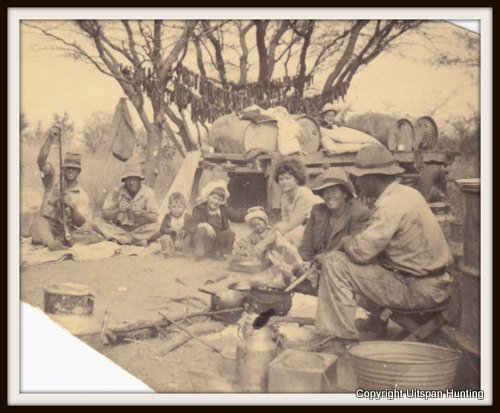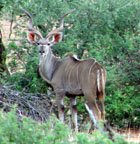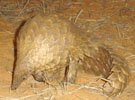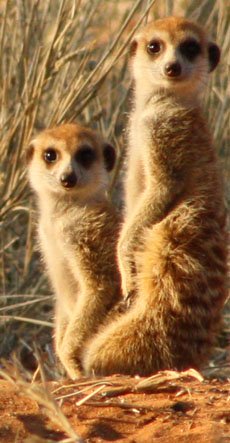For more information about our hunting safaris, don’t hesitate to reach out and contact us!
Doin' the Mombo
by John deWeber
(Blaine, WA)
As Frank Heger was leading me on hands and knees over some of the most rocky geography you've ever seen and through hideous thorn bushes loaded with every imaginable prickly object or creepy insect, I was catching up on my childhood crawling whether I needed it or not. I was pretty confident this wasn't going to help me adjust to adulthood in the slightest.
Here I was in Africa on my dream hunt, and I was on my hands and knees. What in the world would prompt a grown man to subject himself to something so ridiculous?
This whole thing started about a year ago when I got a call from my hunting partner, Gale Palmer, saying that he had booked "us" on an African safari. I'm always up for a new escapade, so I said "Why not?" During that year, we dreamed and planned and packed and got ready for this big adventure.
But not one time did anyone mention anything about crawling on my hands and knees through snake infested terrain. Oh, we were told there were snakes all right, but we were assured that we would not see any. As you crawl through bushes and grass with your nose twelve inches from the ground, what else do you expect to see? I had visions of me and a black mamba doing the mombo.
Our first full day in Namibia began with a grand, European style breakfast of cold cut meats, cheeses, assorted breads, scrambled eggs and bacon, all washed down with a cup of strong coffee. I think they were trying to numb me up for what lay ahead. Then it was out to the target range to make sure our rifles made the twenty-four hour marathon trip without loosing zero. After a few shots, we were satisfied that Gale's new steel gun case had done its job.
Frank spent another two hours with his comprehensive and informative hunting orientation. He gave us guidelines on gun safety, how to shoot off a set of sticks, proper shot placement on African game and methods of stalking. You would think that with a couple of college degrees, I would have picked up on his little dog and pony thing about crawling on my hands and knees. We even had to practice it, but he didn't say we would ever really have to DO IT.
Then it was back to the house for more food. Seared tenderloin of gemsbok, steamed vegetables, mashed potatoes and gravy and lots of tea.... more of the "numb him up" thing? I could get used to this kind of cooking. If we kept this up, they'd have to roll me out of this place. We took a short nap to let our lunch settle, had another round of tea and cookies, and it was finally time for our first hunt.
I was filled with anticipation and excitement. My mental vision of an African hunt was to ride along in some open safari truck, complete with a brown, white and pink stripped canvas awning to keep the sun off my bald head, spot a group of clueless animals grazing peacefully on the open prairie, pick out the one I wanted, and dispatch it quickly and easily. Boy was I in for a surprise!
We pulled past the front gate and Frank started slowly cruising through the bush on what may have been considered a road a century ago. The idea was for someone, usually one of the Namibian trackers, to spot game and then we'd execute a stalk. I was sitting in the front seat of the old Willies Jeep with my Browning 338 Win. Mag. secured to the dash in front of me. Gale and my brother-in-law Dave Gordon were riding on elevated seats in the back. The Jeep is equipped for maximum visibility while being able to transport several hunters.
I was amazed at how quickly the trackers could spot game. Martin, one of the three men on Frank's crew, was along this afternoon and it didn't take long for him to click his two-way radio which signaled that he had seen animals. It took me a bit longer to catch movement and recognize it as game. At least two hundred yards into the bush, I made out several Gemsbok, often known as Oryx.
They seemed to be playing as they chased each other back and forth through the trees. These are beautiful animals with saber-like horns that end in a point about thirty-six inches from the head. They are an aggressive animal that you might not want to challenge in fencing.
Frank slipped out of the jeep, told me to chamber a round and follow him. He placed me between himself and Martin and off we went. Sneaking the best we could, we stole through the underbrush at a snails pace. Up ahead, we saw movement but again they were on the move, streaking through bush, the afternoon sun highlighting their beautiful, sleek bodies, putting distance between us. We kept pressing on and I was wondering how Frank knew where to go. We saw them at least two or three more times and we just kept moving on.
Finally, Martin pointed far ahead and whispered something in Afrikaans (the language used by those born in Africa but of European descent). We ducked behind a bush and Frank motioned for me to be quiet. What did he think I'd already been doing? We moved on at the pace of a three-legged turtle, always trying to keep something between us and the Gemsbok. It was then that Frank indicated he wanted me on my knees. I looked ahead and it was nothing but rocks, stickers, thorns, more stickers and tall grass. Frank led the way and I followed, using the butt of my rifle as one of my hands. I hope he didn't think this was fun. I pinched myself to make sure I was really here in Africa doing what I had dreamed of for so long.
Slowly, we inched our way closer and closer to the unaware Gemsbok. They had finally settled down to rest in the middle of a dry, sandy riverbed. I was assured that at one time or another, there had actually been water running through this area. Some of them were lying down and some were standing. It appeared that every angle was covered by an alert animal and it was not easy to approach these wary creatures undetected. We were trying to remain below the level of the tall grass. Frank pulled to a halt behind a tree and we glassed through the branches. There must have been twenty Gemsbok and they were nervously milling around. In this country, there is always something after you. You are either prey or are being preyed upon and your survival depends on awareness.
We glassed the group and Frank told me to look at the third animal from the right. He said she was a large cow with nice horns. She was standing straight on staring holes through the tree we were pinned behind. We slid out from behind some branches giving me an open shot. Though our movement was painfully slow and low, the Gemsbok became edgy. They began fidgeting around looking for the danger they "felt".
This had been an unusually wet fall and the grass was tall. Without the ability to see clearly, the animals were on a semi-permanent state of alert. I continued to glass and saw another animal that looked a bit bigger than the others. I whispered to Frank to check it out. He said it was a nice bull and I could choose which one I wanted. I opted for the bull.
Frank set the Stony Point shooting sticks up and I placed the forearm of my rifle in the "V". This was a new experience, as I've never shot off sticks before. The bull turned broadside while some of the others slowly began moving away. I settled the crosshairs of my Leopold scope low behind his front shoulder and squeezed the trigger. Maybe I should rephrase that; I "yanked" the trigger. At the shot, the herd erupted in a cloud of dust.
There was no way I was going to follow the bull to see if he was going to fall. I just watched as the last ones disappeared. Everything became eerily silent as even the birds had momentarily quit squawking.
Frank jumped to his feet and told me to reload. He quickly set off towards the riverbed. I followed... and that's when I saw him... my Gemsbok bull laying on the ground right where he'd been standing. He was trying to get up. Frank told me to shoot if he made it to his feet. We moved in and Frank told me I had clipped the spinal column. He was not going anywhere but needed the final shot. At thirty yards, I put one into the heart. It ended as quickly as it had started.
I was soon standing over a spectacular Gemsbok bull with long sweeping horns and a beautifully marked face. This was real. I had just taken my first African game.
After hands were shaken and pictures taken, the animal was loaded into the back of the jeep and we made the trip back to the ranch. There, the animals are caped, skinned, cleaned, quartered and put into the cooler. From the time they are down to the time they are in the cooler is not much over an hour. Frank has an efficient system and nothing is damaged or wasted. The animals are treated with respect and the meat kept clean for consumption. We found Gemsbok to be some of the best meat we've ever eaten.
Frank measured the horns of my Gemsbok and they taped out at 220 points, easily qualifying him as a gold medal bull. I wasn't all that concerned about what medal he qualified for; I just wanted a nice specimen to hang on my wall, but this was a bonus.
If crawling on your hands and knees through rocks and thorns and bugs, with the prospect of hooking up with a black mamba to do the mombo appeals to you, this is the place you want to go.
And who knows, it may take you back through some skipped childhood development and you'll come out a better person. I know I am.
John deWeber
Comments for Doin' the Mombo
|
||
|
||
|
||
|
||
|
||
|
||
|
||
Meaning of "Uitspan"
'Uitspan' is an Afrikaans word that means place of rest.
When the Boer settlers moved inland in Southern Africa in the 1800's, they used ox carts. When they found a spot with game, water and green grass, they arranged their ox carts into a circular laager for protection against wild animals and stopped for a rest.
They referred to such an action of relaxation for man and beast, as Uitspan.

(Picture above of our ancestors.)
Did you know? Greater Southern Kudus are famous for their ability to jump high fences. A 2 m (6.56 ft) fence is easily jumped while a 3 m (9.84 ft) high fence is jumped spontaneously. These strong jumpers are known to jump up to 3.5 m (11.48 ft) under stress. |
to read about my experience...
Did you know? Some animals have one sense more than man!The flehmen response is a particular type of curling of the upper lip in ungulates, felids and many other mammals. This action facilitates the transfer of pheromones and other scents into the vomeronasal organ, also called the Jacobson's Organ. Some animals have one sense more than man!The flehmen response is a particular type of curling of the upper lip in ungulates, felids and many other mammals. This action facilitates the transfer of pheromones and other scents into the vomeronasal organ, also called the Jacobson's Organ.This behavior allows animals to detect scents (for example from urine) of other members of their species or clues to the presence of prey. Flehming allows the animals to determine several factors, including the presence or absence of estrus, the physiological state of the animal, and how long ago the animal passed by. This particular response is recognizable in males when smelling the urine of a females in heat. |




